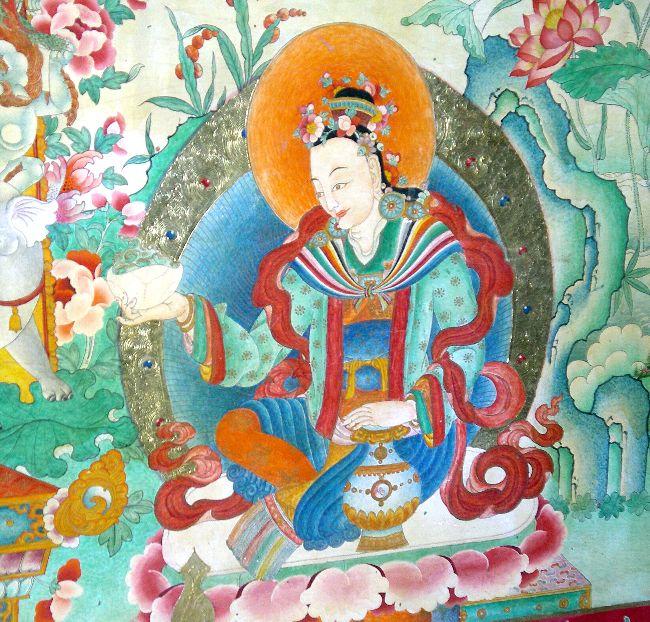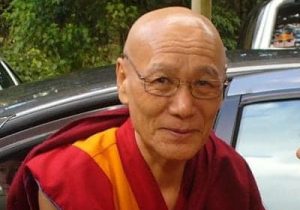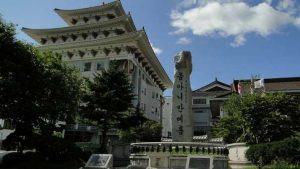No one exemplifies the perfect enactment of guru yoga the way Yeshe Tsogyal has. As a student, teacher, then buddha herself, her story is deeply inspiring. I like to read it every couple of years, as it feels fresh and relevant at every reading. I marvel at the way the terma of her life story feels so relatable, even centuries later, in a completely different culture and country. For those who are resolute Vajrayana practitioners, the path of guru yoga is seemingly complex yet also quite simple.
In the life of Yeshe Tsogyal, we see an earnest student who clearly had past life karma connected to her teachers. She was born a being ripe for realization. Her birth itself was miraculous. She then met her guru, trained as a disciple, endured many trials, received teachings, and engaged in practice. As a budding teacher, she developed the qualities of a realized being, attaining signs, and eventually became a teacher, taking on the role of benefiting and teaching many humans. Eventually, she concealed great precious treasure teachings for future generations and attained buddhahood.
Her life story takes us through all these stages in detail. And the story feels very personal, as if we are there in that time, or she were here in ours. We can relate to her trials and tribulations, her doubts and confidence issues. Seeing someone so relatable move through these stages of attainment and realization to become a great teacher, and eventually a buddha, gives us ordinary practitioners a sense of hope that we, too, at whatever stage we are, can eventually attain enlightenment—whether in this or a future lifetime. Her spiritual biography (namthar) is a form of nourishment for the meditator.
Guru yoga—lama’i naljyor—means mixing one’s mind with the teacher’s mind. The concept is simple, although it may be easier said than done. It is dependent on faith, the kind mentioned in Part One of this series. Not blind faith, but confidence based on maturity and personal research into the lama’s Dharma character—as opposed to ordinary personality traits. Once we qualify and accept a teacher, we rely on our confidence in the guru and see them truly as a buddha, so that our mind may ripen by their teachings and example.
As my precious Lama Tharchin Rinpoche put it: “Our lama is the emanation of all past buddhas, the regent of all present buddhas, and the source of all future buddhas.” Therefore, they are kinder to us than all the buddhas, as they are present here in this very lifetime to show us perfect love, compassion, and wisdom, which are the qualities of a true lama. La-ma means nothing higher. Therefore, the lama is the highest source of inspiration and emulation for us as practitioners.* As Patrul Rinpoche so eloquently states, quoting tantra:
Better than meditating on a hundred thousand deities
For ten million kalpas
Is to think of one’s teacher for a single instant.**
There is no difference between meditating on our own lama, Guru Rinpoche, or Yeshe Tsogyal. As Dzongsar Khyentse Rinpoche puts it: “Yeshe Tsogyal is actually the voice of Guru Rinpoche. In fact, she is Guru Rinpoche in feminine form.”*** It is vital to have a living teacher in the present, but we also take the great masters, such as Yeshe Tsogyal, as our timeless gurus. Therefore, preserving her legacy in the modern world is of utmost importance, as well as praying to her as the guru.
Yeshe Tsogyal’s path from student to adept to teacher to enlightened being depended fully on her relationship with her teacher, Guru Rinpoche (Padmasambhava), whether he was nearby or not, or even in his bodily form any longer. And despite her lamentations about the limitations of being in a female form—based heavily on the patriarchy of the times—her teacher made it clear that her female incarnation was a benefit for realization:
Kyema ho!
Yogini seasoned in the Secret Mantra!
The ground of liberation
Is this human frame, this common human form—
And here distinctions, male or female,
Have no consequence.
And yet if bodhichitta graces it,
A woman’s form indeed will be supreme!****
As she progressed on the stages of the path, ever connected with the mind of her teacher, Yeshe Tsogyal received further instruction and acknowledgement of her attainments. Still, no matter how much she matured, progressed, or attained, guru yoga remained the foundation of all such advancement. All practices, no matter how high or sublime, are in essence, guru yoga:
Kyema!
Hear me, Blue Light Blazing, dakini in truth!
Much counsel in the past and much instruction have I granted you.
All is gathered in this key point: practice Guru yoga.*****
As she became a realized teacher, Yeshe Tsogyal enacted activity as a terton, or treasure concealer/revealer:
. . . in order to attend to the Dharma Treasures and to achieve the benefit of infinite beings, the Lady went on foot to all the major and minor sacred places, hidden lands, and important sites. Lady Tsogyal reflected to herself: ‘I have brought about the benefit of beings and of the Doctrine. Of the lifespan predicted for me by the Guru, half has now gone by. My awareness has reached its widest compass, and my activities likewise. I will therefore go to all the places blessed by the precious Master. There I shall conceal the Treasures, make prayers of good auspices, and engage in meditation.******

Concealing and/or revealing treasure teachings is essential to the path, as during times of great strife or upheaval or negativity toward Buddhist doctrine, which we are seeing in this very lifetime, texts and teachings must be concealed for their preservation, and to serve the beings who will most need them in the dark times to come. We are living in one such time now, so these teachings are more precious than ever. Yeshe Tsogyal is more than a mere historical figure of our admiration. Scholar Holly Gayley has written on Yeshe Tsogyal and her emanation, Khandro Tare Lhamo, that:
. . . for Tibetans, Yeshe Tsogyal is more than an ancestor from the distant past or simply a role model to affirm women’s potential for enlightenment. Indeed, she remains an active presence in the lives of Tibetans—both men and women—through rituals dedicated to her and through the historical women who serve as her emanations.*******
Connecting with the sublime story of Yeshe Tsogyal serves as nourishment and support for our practice in these dark times, predicted in detail by Guru Padmasambhava. Practicing guru yoga and devotion brings us back to the timeless awareness and bigger picture of our many lifetimes meditating for the benefit of all sentient beings, ourselves and the Earth included, so that all might be free of suffering. To remember that timeless awareness lifts the veil of confusion, depression, hopelessness, and fear; to remember that we are always loved and seen by the inner gurus of our many lifetimes. As Yeshe Tsogyal departed her earthly body for the pure lands, she spoke to her disciples, saying:
For a time now, while your dualistic minds persist,
It will seem that I have left you but take heart.
When your dualistic minds subside, you will see that we were never parted.
May health and happiness embrace the very limits of the sky!“When she had finished speaking, an intense and powerful light shot away, darting, sparkling, dancing to the southwest.” ********
* Paraphrased from an English translation of Lama Tharchin Rinpoche speaking on guru yoga at the Open Secret Bookstore, 26 January 2009. Translator, Lama Ngawang Zangpo. Listen here.
** The Words of My Perfect Teacher, Patrul Rinpoche, Padmakara, Shambhala, 1998, p. 310.
**** Lady of the Lotus-Born: The Life & Enlightenment of Yeshe Tsogyal, Changchub & Nyingpo, Shambhala, 2002, p. 140.
****** Lady of the Lotus-Born: The Life & Enlightenment of Yeshe Tsogyal, Changchub & Nyingpo, Shambhala, 2002, p.152.
******* Who Was Yeshe Tsogyal (Lion’s Roar)
******** Lady of the Lotus-Born: The Life & Enlightenment of Yeshe Tsogyal, Changchub & Nyingpo, Shambhala, 2002, p.206.
See more
Khandro Tuktik (Rigpa Wiki)
Related features from BDG
My Perfect Teachers – A View into Guru Yoga, Part One
Yeshe Tsogyal
The Reawakening of Tsogyal Latso: Birthplace of Yeshe Tsogyal—a Generation Reborn
Ecstasy: The Path of Joy
Tibetan Yoga, the Hidden Treasure of Tibetan Buddhism: An Interview with Ian A. Baker
Sarah Beasley (Sera Kunzang Lhamo) on Discovering the Treasures of Lineage
















